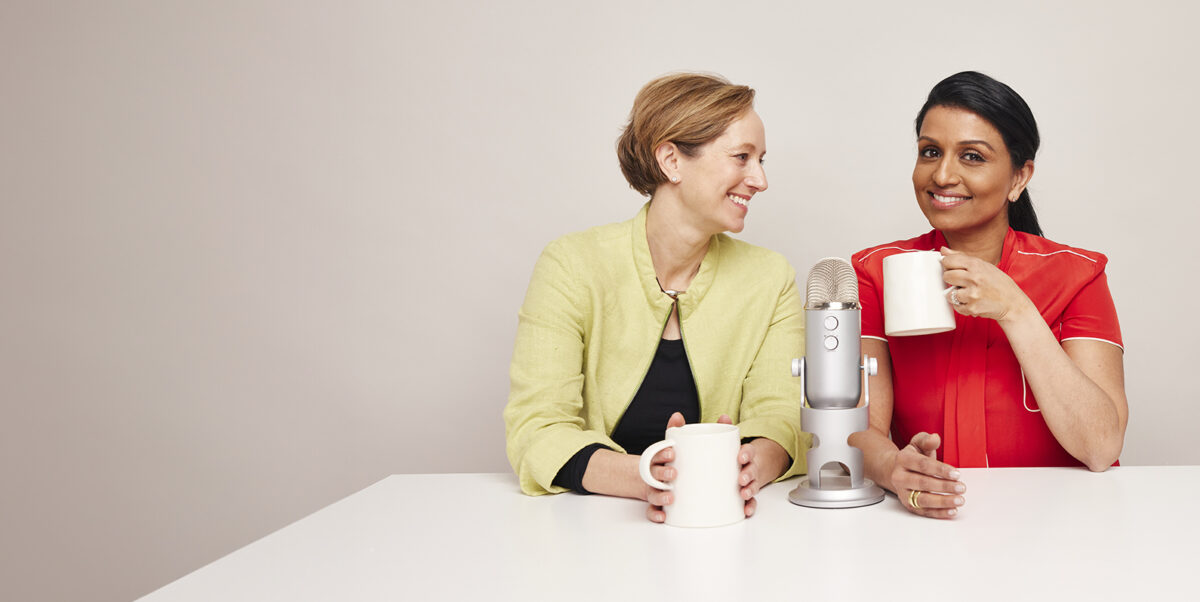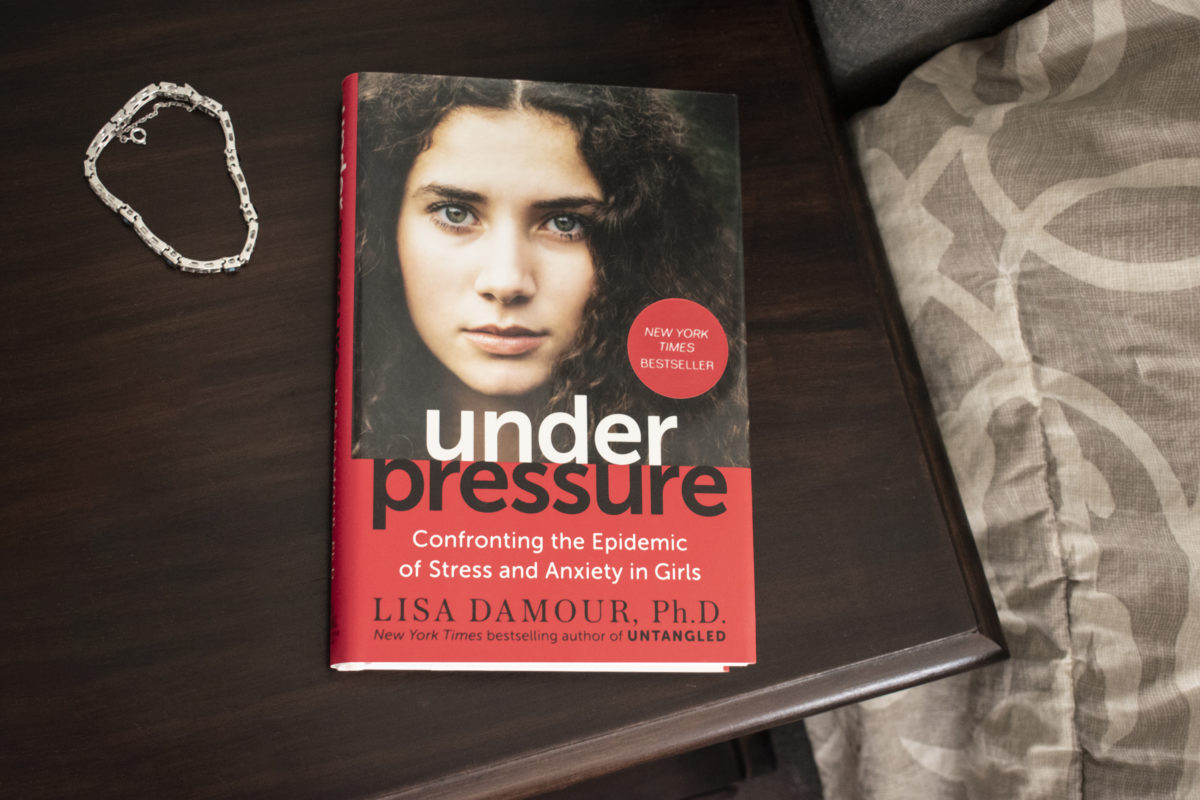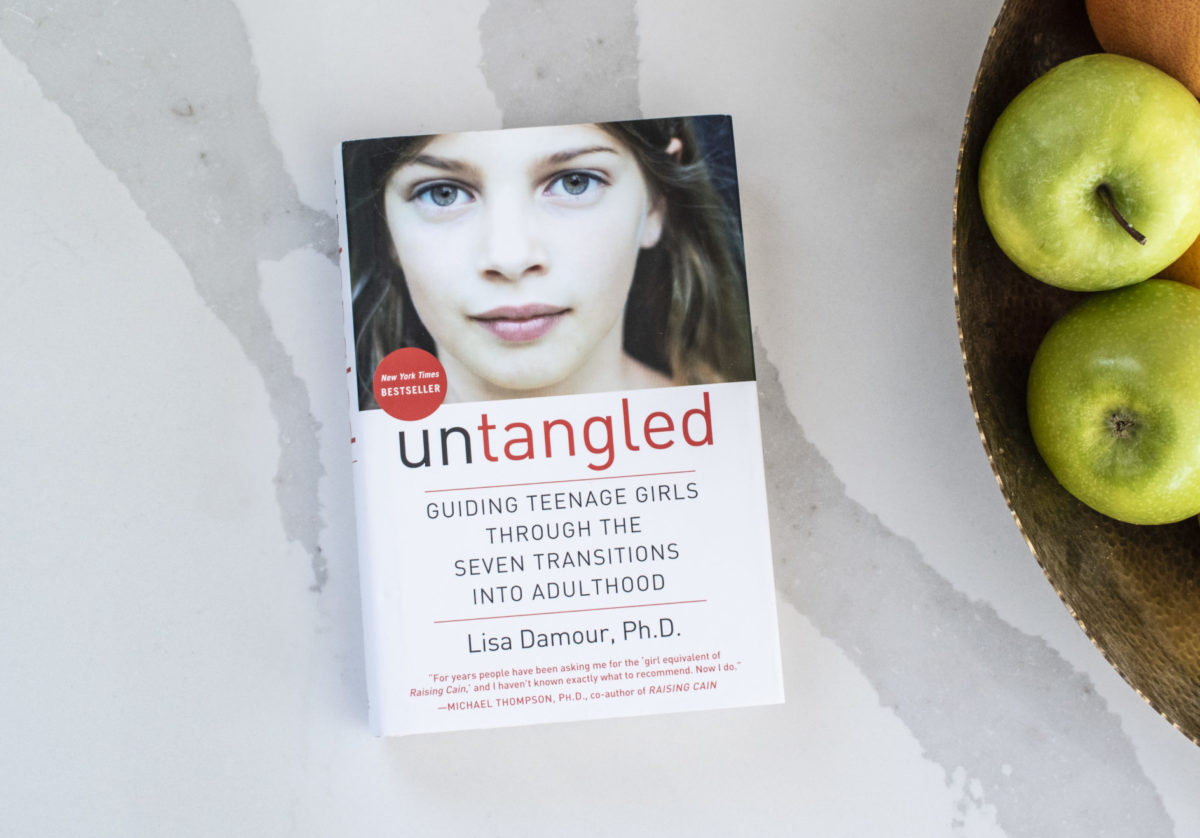A parent writes in asking for help for their teen who feels intensely anxious about going to school and interacting with adults outside the home. Dr. Lisa explains that the need to stay close to home during the height of the pandemic has made it hard for many young people to spread their wings now. Dr. Lisa and Reena discuss the root causes of clinginess and separation anxiety and how those causes can differ depending on a child’s age. Their conversation addresses what adults can do now to help young people understand anxiety, get the upper hand on their nerves, and find their way back into the world.
November 15, 2022 | 32 min
Transcript | My Clingy Teen Hates Going to School. How Do I Help?
Ask Lisa Podcast, Ep. 94: My Clingy Teen Hates Going to School. How Do I Help?
The Ask Lisa Podcast does not constitute medical advice and is not a substitute for professional mental health advice, diagnosis or treatment. If you have concerns about your child’s well-being, consult a physician or mental health professional.
REENA: I know we talk a lot about anxiety, but I feel like it’s everywhere. I feel like sometimes even I have it as we’re reemerging back to our old ways and I find myself not wanting to leave my home sometimes, because I’ve become so used to it.
LISA: I know.
REENA: And you always say Lisa, that I’m such an extrovert. So if I am having trouble dealing with that then I can’t imagine how everyone else is doing and coping.
LISA: No it’s true, you know, and I think sometimes if you read the headlines you’re like I think I just want to go pull the covers over my head.
REENA: Yeah.
LISA: And stay home today.
REENA: Totally.
LISA: I have a lot of empathy for that perspective.
REENA: I don’t want to separate from my home, but some people don’t want to separate from their parents, and it’s interesting. We got this letter about a teen who might be suffering from separation anxiety, I want to get you to weigh in on this. It says, ‘Dear Dr. Lisa, my 15-year-old daughter has separation anxiety. She loves being with me and her mom and hates going to school. I work from home, so she’s constantly asking to be homeschooled, but my sense is that would only make the situation worse. While she does get herself to school each day, she still struggles to be away from us on the evenings and weekends. Last weekend we were out running errands and the lot at our dry cleaners was full. I gave her the ticket and some cash, and asked her to run in and pick up or dry cleaning while I waited in the car. She immediately got shaky and scared, and said she couldn’t do it. I spotted an opening in the lot so we were able to go in together, but I started to feel really worried about how tightly she clings to us and what that will mean to us going forward. Please help.’ You know, I understand separation anxiety in like a 3-year-old going to preschool, but is that normal for a 15-year-old?
LISA: Oh that’s such a good question. You don’t see it so often in 15-year-olds, but I will tell you, post-pandemic, we’re seeing it a lot more often than we used to. And so this I think is a letter that’s probably going to resonate with a lot of parents of tweens and teens, where their kid is just very uneasy being away from them and operating independently, and I’m not entirely surprised we’re seeing more of this when kids were so close to home for so long.
REENA: I mean I was talking about how like I don’t like leaving my home. So I feel this parent and this teen’s pain, because I think we’ve created this cozy environment in our home where you feel safe and still able to function, but what really leads to this sort of situation?
LISA: Well it’s interesting Reena. Like let’s imagine you and I were having this conversation in 2019. And we didn’t have the lockdown and the very very close to home, and like you say, discovering you don’t really have to leave your home all that much to do a lot of the things you want to do.
REENA: Exactly.
LISA: There’s real light in realizing you can pretty much operate in elastic-waist pants a lot more than you thought you could, right?
REENA: That’s true.
LISA: So the way we have thought about separation anxiety, and I will say, often in light of thinking about younger kids, sort of three and up, you know, yeah, kind of preschool and early elementary school kids, is that it can be accounted for by very high levels of anxiety overall, where a kid only feels safe in the parent’s presence. The other explanation that has been useful to me clinically, and that I want parents to have, again, especially when thinking about younger kids, is that sometimes a child who is struggling to separate from their parents is mad about something.
REENA: Oh really?
LISA: Yeah.
REENA: What makes you say that?
LISA: Well it’s interesting because sometimes they’re mad because a new baby has come into the family or sometimes they’re mad because the parent has gone back to work and is not as available as the parent used to be or sometimes they’re mad because, you know, they had to move homes and they didn’t want to leave the old home. And through an unconscious process, sometimes kids will cling to their parents as a way to deal with their angry feelings, and here’s how it works: part of it is that with little kids, they worry that their angry feelings are dangerous. That their angry feelings could really hurt somebody. This is something little kids worry about. And so that child who may be unconsciously quite angry at the parent for having another baby may worry that their anger has harmed the parent or could harm the parent, and so how the child reassures themself is that they don’t let the parent out of their sight. So that’s one element. And again we’re talking little kids, this is not the dynamic for teenagers, but I do want to lay it out, just so people have a good developmental landscape of what separation anxiety could be about. Interestingly, another dynamic that can be at play simultaneously, is that sometimes kids, and this is also true of teenagers, let us know what they’re feeling by making us have that feeling.
REENA: Oh wow. Really?
LISA: Yeah. And so when I have worked clinically with a family, let’s say of a 6-year-old who has separation anxiety, what will often happen in my office is they will describe what’s happening. You know, we try to take him to school and he clings to my leg. We try to, you know, go out on a date and he is so upset that he’s almost vomiting. I mean they’ll describe this kid who is just really really suffering. Really really suffering. And we’ll talk about this suffering, and then sometimes I will say, and you have to go on instinct here, I’ll say, is there a part of you that’s also finding this a little frustrating for you? And the parent will often be like, yes, like this is so hard. Like I’m feeling really annoyed with him but it’s also hard because he’s in so much pain I don’t want to get annoyed with him. But yes I would like to be able to go on a date and yes I would like to be able to drop-off at school without all of that intense upset feeling. And so understanding that in separation anxiety, especially for little kids, feeling mad about something, feeling frustrated about something can be an element, opens up a path for intervention. And so I just want folks to have on their, you know, menu of things to do if they’re dealing with separation anxiety at any age, one option is to say to the kid, you know I see you’re super anxious about going into your classroom or staying with the babysitter, some times kids also feel mad about not being included in the parents evening. Do you think that might be something that’s happening here? Just putting it on the table. So not accusing the kid of anger, not accusing the kid of trying to be manipulative or diabolical, but I want that as an opportunity that parents have if they’re like, I can’t get to the bottom of this. Knowing that side-by-side with what is really truly a lot of anxiety, there can also be some real frustration in that child that’s being expressed in this sort of real clinginess is a useful thing to have as a way to sort of understand some forms of this.
REENA: Wow. So this concept of maybe the teen saying that I want to be homeschooled, what do you think of that?
LISA: Well, so my hunch is, so okay, now we’re back to 2022. We’re having the conversation now. I would not ascribe this to an unconscious anger that’s being expressed in the form of separation anxiety. I would really in most likelihoods, and especially with an adolescent, ascribe this to the kid missed out on all of that practice of moving further and further away from home that normally would have happened. I mean if this is a 15-year-old, what we can picture is, you know, the pandemic probably started around when she was 12. Right? Which is when kids are just branching out. So just at that moment when she would have practiced all that independence, she was grounded. And so I think that for her, I probably wouldn’t say like, are you also mad? Like is that what’s happening here?
REENA: Right. Exactly.
LISA: I also really think that, you know, post-pandemic especially, as a clinician, I’m always going to favor the straight up anxiety explanation.
REENA: Regardless of pandemic or no pandemic?
LISA: Or actually, especially because of the pandemic.
REENA: Oh, okay.
LISA: Just because kids really lost the opportunity to practice independence and so now they’re really freaked out by independence.
REENA: You said that we have lost some years for some of these teens, where they would be building independence. What do you do now to get that back? Is it too late?
LISA: It’s not too late. And so the dad’s instincts in the letter are spot on, where he’s like, she’s trying to be homeschooled, you know, this is not outside the realm of possibility, but we’re pretty sure that won’t help. The dad is right. That one of the things, actually, the thing we want to be focusing on here as we help kids get back into the world and as we help kids who are feeling really anxious about getting back into the world, the cardinal rule, the thing we will always want to hold front and center is avoidance feeds anxiety.
REENA: That’s a good one.
LISA: If we avoid something we get more anxious about it. Okay. So she wants to avoid school, and the dad’s like, you’re going to school, and that is right. Because here’s the thing, if she’s feeling scared about school, and her anxiety is spiking, which it sounds like it is, scared of leaving home to go to school. If the parent says, okay, nevermind, you don’t have to go, what’s going to happen is her anxiety is going to just ease immediately. She will feel so much better, so what you’ve just have set up is a reinforcement process, where she feels anxious, she’s told she doesn’t have to go, and then she feels better. So the next time she feels anxious about school, she’s going to be like, I know the solution, don’t make me go, that will help me feel better. And so it entrenches itself as a solution for the anxiety.
REENA: I want to go back, Lisa, to this drycleaning situation. First off, I think this dad is awesome, first for writing-in about this letter and the instincts of the dad is just so great. But in that drycleaning situation where he handed her the ticket and she started shaking and didn’t want to go in by herself, what do you think he should have done in that moment?
LISA: Okay. So the really good thing about anxiety treatment, as we do it in our offices and practices, is that it’s pretty straightforward. So I have no problem recommending a kind of DIY approach for parents. Like what we do in our offices you can do at home. So in situations like this, what we would do is what we call graduated exposure, which is essentially babysteps. Which is, okay, so maybe on this day the kid is so overwhelmed that she really cannot run in and grab the dry cleaning on her own. Like that looks like it is outside the realm of possibility. But what we would want him to do, it sounds like he found a parking space, what we would want him to do is to have some version of her trying to do the thing she’s scared of doing. And so it may be that he says, okay, let’s do this. You come with me into the dry cleaner, but I’m going to ask you to go up to the counter and talk to the person and get our dry cleaning and pay and bring me back the change. I will stand in the dry cleaning with you, but you’re the one that needs to go up to the counter to do it. So something like that would be what we would want to have happen, again, on that principle, Reena, avoidance feeds anxiety, avoidance feeds anxiety. And so some level of engagement with what is being asked of her is really really important to do.
REENA: Wow. I never thought that you can meet them halfway, or do something slowly so they get used to it. Do you find, though, when you do these little baby steps, what stops them from moving forward? Like maybe they can take that baby step but they can’t take the second or third one.
LISA: Well that’s often the case. Right? Where the kid’s like, no, I can’t even talk to the person.
REENA: Right.
LISA: Like no, I cannot do it. And that may be true. Like you can’t make 15-year-olds do anything, they are big, like you can’t make them do stuff. So then I think the parent might say, alright, then you need to stand next to me while I do it, and you need to hear me do it, and then next week you’re coming with me to the dry cleaner, and you’re going to do it. But between this week and next week we’re going to help you manage your anxiety. And I think that one of the keys, when we teach graduated exposure in therapy, is we don’t just throw people in. We also give them a lot of practice with bringing their anxiety back under control. And breathing is a really key thing that can do a lot of power on that, that can actually help reduce anxiety a lot, that controlled breathing, we know hacks into the system that turns off the anxiety alarm. And so what I would do as a parent in this situation, if the kid’s like, no, I cannot do that, is I’d say okay. Next week we’re doing it, but between now and next week, every night we’re going to practice controlled breathing. And you’re going to practice bringing your anxiety down with breathing, so that when we do go in next week to pick up the dry cleaning, if you’re starting to feel too anxious, you can use your breathing to get that back under control.
REENA: And the breathing really helps?
LISA: It really helps. It really helps. Vastly more than I think a lot of us expect. And what we think is happening in that moment is that the nerves on your lungs, we have nerves that monitor our breathing on our lungs, are noticing that we’re breathing deeply and slowly, and they take that as an indication that we’re safe, and they send that messaging to the brain. So it’s a very powerful way to bring anxiety down, and so it’s also a nice way of meeting kids halfway, to say, look, I’m not going to throw you in and hope you survive.
REENA: Yeah.
LISA: Like I’m going to teach you strategies that if your anxiety becomes quite intense, you can get it under control, so that you can ask for our dry cleaning and offer the money and give it a shot.
REENA: You know, the concept of breathing, can you walk us through what that’s really like? I think it’s helpful for adults or kids, like what’s a basic technique?
LISA: So the one I use, when I feel too anxious, I call it square breathing, lots of people call it box breathing, but it’s the same idea, which is, I breathe in slowly on the count of three, I hold it for a count of three, I breathe out slowly for a count of three, and then I wait for a count of three.
REENA: So three three three.
LISA: Three three three three. And so what’s good is, while you’re counting and breathing you kind of can’t think about anything else. So whatever you were feeling anxious about, like you can’t continue to focus on it. Like the breathing and the counting takes all your concentration. And the other thing I do is I really try to picture these nerves on our lungs, I try to picture how we’re breathing, I try to picture them getting the new information, like everything’s okay, we’re breathing deeply and slowly, we only do that when we’re safe, and sending that up the brain. And it’s really powerful as a way to get anxiety back in its box. And so if you think through, so think through with this girl, what we might ultimately, if we try to lay out the gradual exposure programs, maybe the first weekend dad goes in with her, and she has to stand next to him while he puts in the order for dry cleaning. The next weekend, they go in together, he’s like I will be in there, but you’re the one going up to the counter. Maybe the next weekend, you know they walk to the dry cleaner, maybe he stands outside the store and she goes up to the counter. Maybe the next weekend he stays in the car. So they lay it out, but breathing all the way. Breathing all the way so that it becomes bearable.
REENA: Oh I love that breathing exercise. I’m going to completely use that, because I just think that we all are under certain levels of stress. Some of us are better at dealing with it, others aren’t, but this is such a great thing to teach your children. I love that. When a kid is panicking about something, when do you put your foot on the gas pedal and when do you put your foot on the brake?
LISA: That’s a good question. In terms of like really pushing them to do something versus backing off?
REENA: Right. Exactly.
LISA: Yeah. You know, you can’t make a panicking kid do something. Even if you’re instinct as a parent, and it’s probably right, is that oh my gosh, I’m not even making them go into the dry cleaner?
REENA: Right.
LISA: But I have a lot of empathy. Like if a kid is really really having, you know, an extreme anxiety response, which is sounds to me like this girl is, I think the only humane and decent thing in that moment is to be like, it’s okay, you know, abort this mission, I’ll run in and get the dry cleaning, but we’re going to go home and we’re going to get a piece of paper, and we’re going to lay out a plan for how you can be the kid who can go in there and get the dry cleaning. Like I don’t think you have to say like, nevermind, but I do think it’s not worth it. But I’ll tell you, you know, there are kids who have been terrified to go back to school. And you know, where parents haven’t required them to go back to school or they were out of school for a long time. And you know, when the parent’s like you’ve got to go to school, the kid’s like, ahhh, I’m not doing it. What I will say to the parent is, see if they can get into the car and just drive to school with you. And that maybe you’ll make a decision once they get to school about whether they can go in. Or maybe you’ll work with the school where the kid goes in and is there for first period and then you check in and see if they need to come home after first period. Or the kid stays in the office for a big chunk of the day. But what we want to do is honor that when kids say they cannot do something, they really may be telling us the truth. We want to give them a ton of strategies for managing anxiety, but we also want to continue to say, but okay, what could you do? What incredibly small increment of what needs to be done here could you do? Because again, avoidance feeds anxiety, avoidance feeds anxiety. It is one of the central tenets of how we understand anxiety in psychology.
REENA: What do you, for people who don’t understand anxiety, or have never really had a panic attack or felt that extreme feeling, what are the signs that parents should look for?
LISA: You know, in some ways it will look different in every kid. Like some kids will look super queasy or some kids will get really irritable or get really weepy. But there are also some great universals of anxiety. Anxiety is a very ancient emotion, you know in some ways, like the anxiety response we have our pets have too. You know, there’s a very kind of universal quality to anxiety. And so what is almost always present is that heart rate accelerates, breathing gets quick and shallow, people are often not aware of this, but pupils dilate, digestion stops. You know, there’s a very intense biological reaction that is anxiety. And what we attach this to is the ancient fight or flight system. You know, that our body is getting ready to either run from something or attack something, and so this is the response we have in the face of a threat. And what’s happening for this poor child is that the dry cleaner feels like a threat. And so her alarm is ringing as though it is a very dangerous place and her instincts are telling her to stay away.
REENA: You know, it might sound crazy to people, you’re just going into the dry cleaner, how do you explain why this can cause so much anxiety in someone?
LISA: Well one thing that happens, and this is again, why we have to work against avoidance, is that their mind will start to imagine the dry cleaner to be a vastly scarier place than it really is.
REENA: Oh interesting.
LISA: So this sweet child may be thinking, I’m going to go in and they’re going to see that I’m a little shaky and then they’re going to be mean to me, and then I’m not going to be able to find the ticket even though my dad gave it to me 10 seconds ago. So they will, in this sort of anxious worry, catastrophize in their minds. They’ll start to picture the situation as cruel, you know, the meanest dry cleaner in the world, which is also why avoidance feeds anxiety. Because, as long as you stay out of that dry cleaner, you get to picture it as the meanest dry cleaner on the planet and nothing gets in the way of you believing that. Whereas once that kid can get to that counter and the dry cleaner’s perfectly kind and the dry cleaner helps make change quickly, that also reduces anxiety. So that’s the double whammy on avoidance. It both feels good to do it and it never lets you check what you believe to be true, which in anxiety tends to be vastly more harrowing than the reality, against what’s actually true.
REENA: So Lisa, if you were to give your top three tips for dealing with separation anxiety, and as you’ve mentioned, we’ve lost some of that independence opportunity for some of these teens. What’s important to keep in mind?
LISA: I think the first thing is it’s real for the kid. Right? I think what you described, you know where you’re like, oh come on.
REENA: Right. It’s just a dry cleaner.
LISA: It’s just a dry cleaner. Like I would have that instinct, you have that instinct, I think a lot of parents would have that instinct, and I think the reality is our kids have been through so much, and things do feel truly scary for them and they haven’t’ had the practice out in the world they normally would have had. And in place of that practice, they’ve had a lethal virus circulating in their world. So I mean, they’re scared, and it’s legitimate. So the first tip would be like, empathize. Like don’t dismiss it, don’t get mad at your kid about it, even if it’s very very frustrating. Like empathize. But then the second tip is don’t give in. Like don’t let the anxiety drive the train. And so then the second tip is start negotiating.
REENA: Oh okay.
LISA: You don’t have to do it today. You don’t have to go in alone. But what could you do? But the third tip, and this is so critical, is to really reassure your kid that anxiety is not a life sentence. That we understand the basics of anxiety so well, we understand that just as the body reacts really strongly and it’s hugely uncomfortable, we can also use the body to get that back under control through breathing, or parents might also look up, there’s systematic muscle relaxation, there’s other techniques we can do where we get the body back into a calm place. And so our job as the adults in the room is to reassure kids, I get it, you’re super anxious now, you’ve come by it honestly, here’s the good news, this does not have to define you.
REENA: That is really good. That it’s not a lifetime sentence. Because it must feel like a lifetime sentence that you can’t get out of when you’re in the middle of it.
LISA: I think it does, and I think especially if you’re a teenager and the moment you’re feeling like it’s going to extend forever in the future.
REENA: Yes.
LISA: That in some ways is the nature of being a teenager. And then, Reena, if you do the math sometimes, like this kid, so let’s say that the pandemic has hit her 12th, 13th, and 14th years. Like let’s say it really kind of covered that time. That’s a huge percentage of the amount of time she has memory of being alive.
REENA: Right? Good point.
LISA: Right? Like we have to give kids some room. Like of course they’re very anxious, this has taken up a big chunk of their lives. But the key thing going forward is to not continue to accommodate to the anxiety if the thing they’re scared of isn’t as dangerous as they think it is.
REENA: Because they’re able to confront it. Even if it’s taking baby steps to confront it.
LISA: Baby steps all the way.
REENA: That’s so good. And a little bit of empathy goes a long way, because you never know what other families are going through. Whether you’re at the dry cleaner and you’re just trying to pick up clothes quickly, you know, because I could see myself, somebody’s taking a long time, you just don’t know what that kid is going through. I feel that. I really feel that.
LISA: Yeah.
REENA: So what do you have for us for parenting to go?
LISA: One of the big resets we need to do in the wake of the pandemic is to get used to the idea that anxiety actually is part of life. Is a normal and healthy function, we feel anxious when we’re faced with a threat, and so that some anxiety is fine, in fact it’s good. Like when I’m taking care of teenagers, you know and they tell me that they showed up at a wild party and they’re really anxious because the party is really wild, I’m like good. Good, you should be anxious at a wild party. To get used to the idea that anxiety’s not all bad. We’re not trying to banish all of it. To not be anxious about anxiety for its own sake. But to make it really clear when anxiety is irrational, and then to use exposure, as we call it, or baby steps, to keep irrational anxiety from running the show. And the definition of irrational anxiety, Reena, it’s like one of my favorite, clearest, most simple definitions in all of psychology, it’s when we overestimate the threat we’re facing and we underestimate our own ability to manage it.
REENA: Wow. Always such good details. And great psychology terms that I didn’t even know existed. So grateful to you Lisa. A lot to unpack here, but thank you so much for walking us through and helping us understand separation anxiety and anxiety in general. Well next week, with Thanksgiving around the corner, Christmas, Hanukkah, New Year’s, we wanted to talk to you about how do you deal with difficult relatives around the holidays. Look forward to that one Lisa.
LISA: Yeah.
REENA: I’ll see you next week.
LISA: I’ll see you next week.
More resources

















